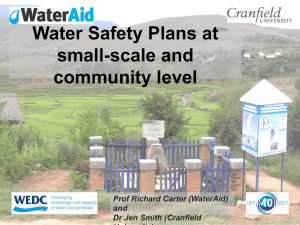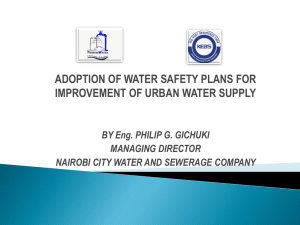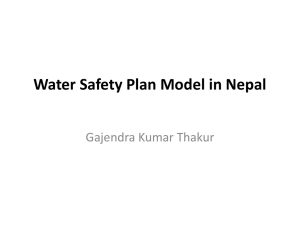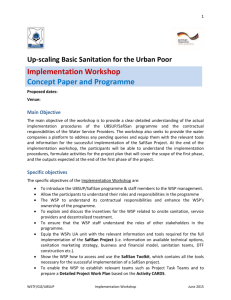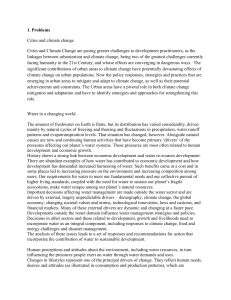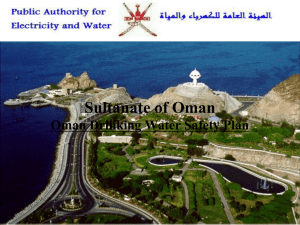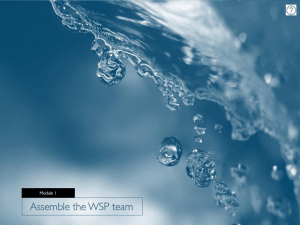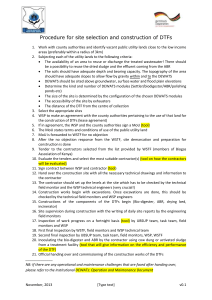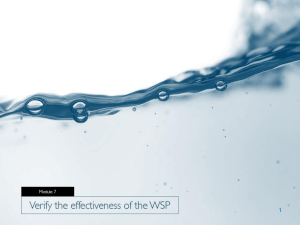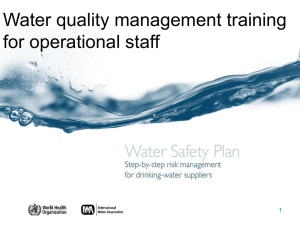Water Quality Monitoring Through Implementation of Water Safety Plan
advertisement
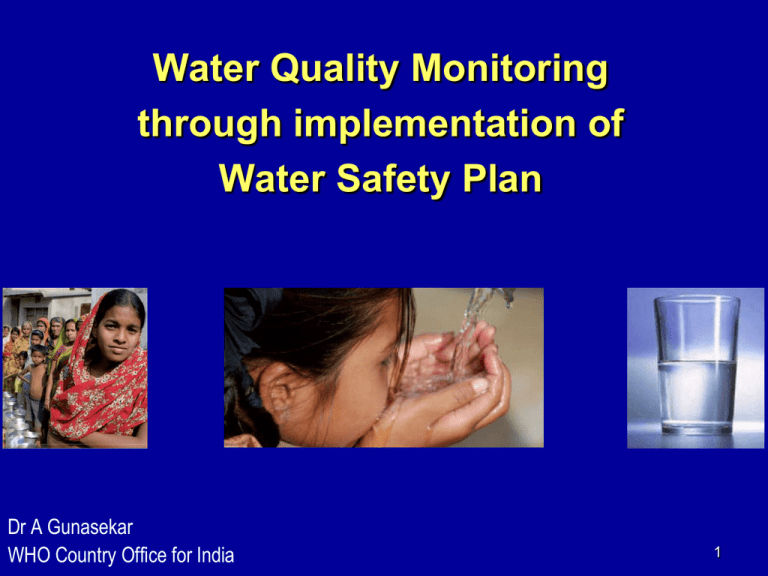
Water Quality Monitoring through implementation of Water Safety Plan Dr A Gunasekar WHO Country Office for India 1 Current situation and challenges • 88% of India’s population is using improved drinking water sources. (Urban – 96%; Rural – 84%); however water delivered at the taps may not always be safe to drink Source: World Health Statistics, 2011 • Diarrhoea is the 2nd leading cause of death among children; About 4 lakh children die in India due to diarrhoea every year, that is one child dies due to diarrhoea every 80 seconds Source: Diarrhoea: Why children are still dying and what can be done, UNICEF/ WHO, 2009 • 88% of diarrhoeas can be prevented by safe water, sanitation and good hygiene 2 WHO Guidelines for Drinking water quality - Water Safety Plans The most effective means of consistently ensuring the safety of a drinking-water supply is through the use of a comprehensive risk assessment and risk management approach that encompasses all steps in water supply from catchment to consumer. The approach is called Water Safety Plan (WSP) 3 What is a Water Safety Plan? Water resources & sources • • • Treatment Distribution system Consumer system A documented plan that: – Identifies hazards, assesses risks from catchment to consumer – Prioritizes risks – with focus on highest risks – Mitigates risks through control measures Moving away from reliance on output monitoring i.e. measuring parameters in final water Move into input monitoring - i.e. measuring parameters which show that the system is working 4 Hazard, Hazardous event & Risk • Hazard is a biological, chemical, physical or radiological agent that has the potential to cause harm • Hazardous event is an incident or situation that can lead to the risk - what can happen and how? (e.g. heavy rainfall) • Hazard identification - Desk studies & Site visits • Risk is the likelihood of hazards causing harm in exposed populations including – Specified time frame – Magnitude of the harm – deaths, disease, financial cost Why do we need WSPs? Gideon, Missouri, 1993 Hazard (contaminant) Salmonella Hazardous event (cause) Pigeons nesting on a water tank roof Tank roof was not sealed and pigeon faeces were washed into the tank Salmonella bacteria got concentrated in the sediment & the surface During a flushing event, the bacteria got rapidly drained into the distribution system and chlorine residual was not enough Effect ~ 500 ill from a town of 1,104 7 Dead 6 Why do we need WSPs? Milwaukee, Wisconsin, 1993 • Hazard (contaminant) – Cryptosporidium cysts • Hazardous event (cause) – Runoff from heavy spring rains – Carrying sewage into Lake Michigan (from which raw water was drawn) – Coagulation problems on the filtration system in the water treatment plant • Effect – 400,000 became ill from 1.2 million – 100 dead Source: Presentation of Mr Asoka Jayaratne, Water Quality Specialist Yarra Valley Water,Melbourne, Australia 7 Why do we need WSPs? Walkerton, Ontario, 2000 Hazard (contaminants) E. coli O157:H7 Campylobacter jejuni Hazardous event (cause) Heavy rains Cow manure washed into a well Failure to chlorinate Water supplied by local water utility Effect – 2,300 ill – 7 Dead 8 Why do we need WSPs? • Recontamination in the distribution lines and at the household level 9 Components of WSP (1/3) 1. A system assessment to determine whether drinking-water supply chain as a whole can deliver water of a quality that meets requirements. Components of WSP (2/3) Identifying control measures in the system that will control identified risks and ensure that the health-based requirements are met. For each identified control measure, an appropriate means of operational monitoring should be defined that will ensure that any deviation from required performance is rapidly detected. Components of WSP (3/3) Management and communication plans describe actions to be taken during normal operation or incident conditions and documenting the system assessment, including upgrade and improvement planning, monitoring and communication plans. Step-by-step risk management 1. 2. 3. 4. Assemble the WSP team Describe the water supply system Identify hazards and hazardous events and assess the risks Determine and validate control measures, reassess and prioritize the risks 5. Develop, implement and maintain an improvement/upgrade plan 6. Define monitoring of the control measures 7. Verify the effectiveness of the WSP 8. Prepare management procedures 9. Develop supporting programmes 10. Plan and carry out periodic review of the WSP 11. Revise the WSP following an incident In simple terms, WSP means: 1. What are the risks? 3. How do we know the risks are under control? Continuous Cycle 2. How do we control the risks? 14 Describe the water supply system • • • • • • • • Source of water Changes due to weather Details of land use in the catchment Water storage Water treatment (processes and chemicals) Storage, distribution network Availability of trained staff Quality of documentation Risk assessment Likelihood Score • Almost certain (once a day) 5 • Likely (once a week) 4 • Moderate (once a month) 3 • Unlikely (once a year) 2 • Rare (once every 5 years) 1 Severity Score • Insignificant / No impact 1 • Minor compliance impact 2 • Moderate aesthetic impact 3 • Major regulatory impact 4 • Catastrophic Public Health impact 5 Likelihood score x Severity score = Risk score Verify the effectiveness of the WSP Treatment works • pH • Chlorine dosing records • Residual Chlorine • Turbidity - Daily Weekly Daily Daily Distribution system • pH • Chlorine levels • Turbidity • Sanitary inspection - Weekly Weekly Weekly Weekly Why do we need WSPs now? • Increasing risks of water quality – microbiological as well as chemicals from industrial and agricultural activities (pesticides and fertilizers) • Increased awareness among consumers on the need to have safe water • Outbreaks (in many countries) - due to (re)contamination of water, after treatment 18 Status of WSP implementation • WSP piloted in over 40 urban and 100 rural supplies in Asia - Bangladesh, Bhutan and Nepal • WSP piloted in Hyderabad and Nagpur municipal water supplies in India 19 Outcomes of WSP: Improved water quality • Water source protection and preservation • Small problems are identified early and fixed, preventing bigger problems • In water systems where WSP is carried on a continuous basis (24 x 7), water is found to be safer to drink with microbiological test results, before and after WSP, showing dramatic improvement 20 Outcomes of WSP: improved management • Standard operating procedures improved • Clear roles and responsibilities • Regular monitoring of water quality in treatment • • plants Promotes conversion to 24x7 supply Reduction in non-revenue water 21 Conclusion • Water safety plan ensures water safety (improves health) and sustainability of drinking water supplies 22 Thank you 23
